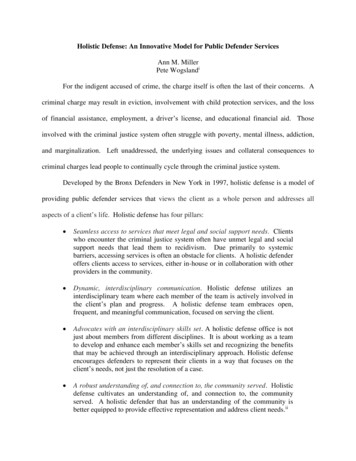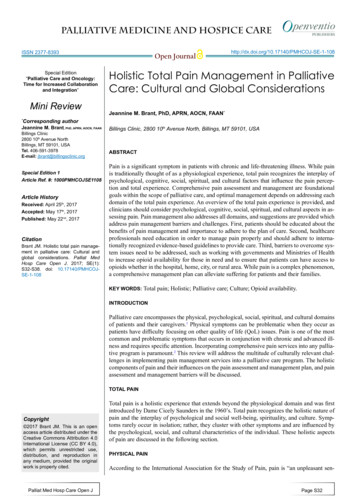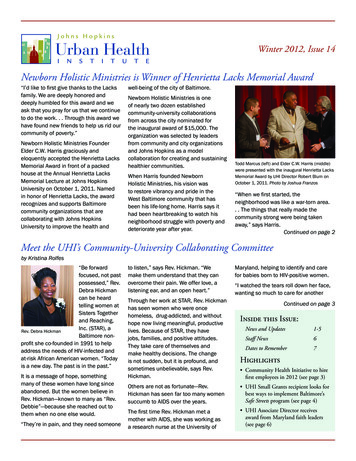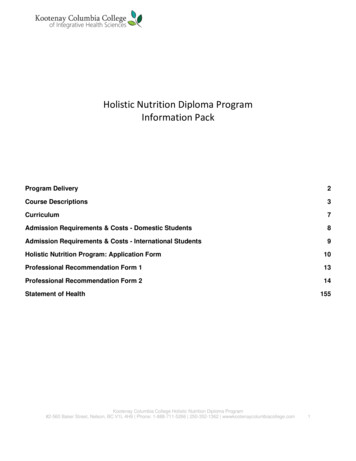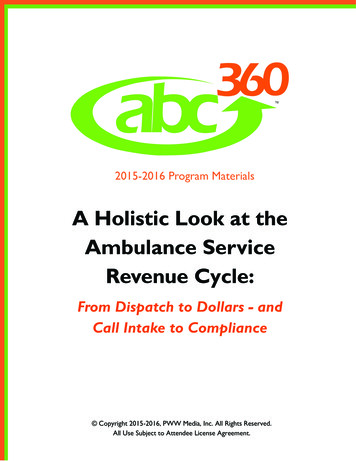
Transcription
2015-2016 Program MaterialsA Holistic Look at theAmbulance ServiceRevenue Cycle:From Dispatch to Dollars - andCall Intake to Compliance Copyright 2015-2016, PWW Media, Inc. All Rights Reserved.All Use Subject to Attendee License Agreement.
Attendee License AgreementLicense and Limitations of UseOnce you (Licensee) register for and/or attend any PWW Media, Inc. (Licensor, hereinafter“PWW Media) Event (including but not limited to abc360, The PWW Executive Institute and anyPWW Media webinars), you agree to be bound by the terms of this License. This License coversany information, materials or training that PWW Media provides, whether written, electronic or oral, and whetheraccessed directly or indirectly through attendance at a conference or access via the Internet (Licensed Materials).Licensee is permitted to print one copy of the Licensed Materials and/or keep one electronic copy as backup.Unless Licensee obtains Licensor’s prior written permission, Licensee may not:Permit anyone but you to use a password or share a link to access Licensed Materials;Provide or forward any Licensed Materials in whole or in part to anyone else;Copy, duplicate or in any manner reproduce or rebroadcast any Licensed Material or use it to train anyone;Copy, modify, sell, distribute, rent, lease, loan or sublicense any Licensed Materials;Record any PWW Media Event (including presentations, questions and answers, individual consultations, etc.)by audio, video, electronic or any other means; Use any Licensed Materials for any commercial purposes whatsoever. Copyright StatementAll Licensed Materials are the Copyright of PWW Media, Inc. unless otherwise noted. All rights are reserved.No claim is made with regard to any governmental works or the works of any third parties used by permission.No part of this material may be duplicated, reproduced or distributed by any means.DisclaimerAlthough Licensor attempts to provide accurate and complete information at all PWW Media Events, Licensorcannot guarantee it. Errors and omissions may occur. Therefore, Licensor presents all Licensed Materials “as is”and disclaims any warranties of any kind, express or implied. The Licensee acknowledges that the LicensedMaterials are subject to change based on changes in law and agrees that Licensor is not responsible to updateand/or supplement any of the Licensed Materials at any time. None of the Licensed Materials constitute legaladvice or a definitive statement of the law and are not a substitute for individualized legal advice under anattorney-client relationship. Licensed Materials are for educational purposes only. Licensee is instructed toconsult the official sources of materials from governmental agencies. Licensor is not responsible in any mannerfor any billing, compliance, reimbursement, legal or other decisions you make based in whole or in part upon anyLicensed Materials, and Licensee hereby forever releases Licensor from any and all claims and liability of any kindrelated to Licensee’s use of any Licensed Materials. Any examples of documentation, coding scenarios and otherteaching illustrations contained in any Licensed Materials are examples for illustrative purposes only. Licensorwaives any and all claims, lawsuits or other actions against PWW Media, its principles and employees and allrelated entities. In all cases, you agree that the liability of PWW Media, Inc. is limited to any amounts paid byLicensee for registering for the PWW Media Event. This Agreement is governed by Pennsylvania law and anydisputes hereunder shall be brought exclusively in the Commonwealth of Pennsylvania, County of Cumberland.Entire AgreementLicensee acknowledges that Licensor, nor anyone else on its behalf, made any representations or promises uponwhich you relied that are not in this Agreement. This Agreement constitutes the entire understanding betweenLicensee and Licensor and cannot be altered unless signed in writing by the principals of PWW Media, Inc. If anypart of this Agreement is declared invalid, it will not invalidate the remaining parts. If Licensor does not enforceany part of this Agreement for any reason, Licensor does not waive its right to enforce it later.
Copyright 2015-2016, PWW Media, Inc.abc360 General SessionsA HOLISTIC LOOK AT THEAMBULANCE SERVICE REVENUECYCLE:FROM DISPATCH TO DOLLARS – ANDCALL INTAKE TO COMPLIANCEThe Ambulance Revenue CycleDefinedThe Ambulance Revenue CycleDefinedThe financial progression of anambulance agency’s accountsreceivable, from the time of the calluntil the time it gets paid.The ambulance revenue cycleencompasses all of the administrative,operational, clinical and technologicalfunctions that contribute to the capture,management, and collection of patientservice revenue.The Ambulance Revenue Cycle“Holistic” Impacted by many drivers and variables But, it’s all interconnected Even activities you don’t think of as“revenue cycle-related” have an impact“When the parts of something are intimatelyinterconnected and can be understood only withreference to the whole.”Page 1pwwmedia.com pwwemslaw.com AmbulanceCompliance.com
Copyright 2015-2016, PWW Media, Inc.The Ambulance Service Revenue CyclePeriodic AuditsOverpayment RefundsCredit BalancesCall intake processDispatch protocolsResponse determinantsPCS FormsPrior AuthorizationsABN ScreeningKPIsFinancial ReportingRevenue Cycle QIDenialsAppealsCollectionsElectronic Remittance AdviceElectronic Funds TransferManual PostingComprehensive Compliance ProgramCompliance OfficerCode of ConductStaff TrainingPayer IdentificationProcedure/Modifier CodingICD CodingChargemasterClaim SubmissionThe Ambulance Service Revenue CycleCan be Further Divided into ThreeGeneral Categories bulance v. WCVMIH/CPSchedulingTransport DeclinationClinical Documentation- Medical Necessity- ReasonablenessOperational Documentation- Dispatch Info/Times- MileageDemographic Documentation-Insurance Info- Signatures“Upstream”Ambulance RevenueCycle Functions“Midstream”FunctionsThe Ambulance Service Revenue CycleDispatch/Call Intake Dispatch protocols Response determinants Non-emergency call intakeDispatch/Call IntakeAuthorizationDeploymentService EncounterDispatch and Call Intake The Ambulance Revenue Cycle beginshere Information gathered here directlyimpacts other phases of the RevenueCycleDispatch and Call Intake Emergency calls Dispatch protocols – necessary formaking “emergency response”classifications Response determinants – translates thedispatch information into a responsemodePage 2pwwmedia.com pwwemslaw.com AmbulanceCompliance.com
Copyright 2015-2016, PWW Media, Inc.Dispatch and Call Intake Non-emergency calls Pre-screening for medical necessity,reasonableness, etc. Allows for appropriate deploymentdecisionmaking later in the RevenueCycleRevenue Cycle Case Study #1The ABC Ambulance compliance officer did aninternal audit and determined that 27% of all nonemergency ambulance transports originating fromSNFs did not meet Medicare’s medical necessitycriteria and could have safely been transported bywheelchair van.The Ambulance Service Revenue CycleAuthorization PCS Forms Prior Authorization ABN ScreeningRevenue Cycle Case Study #1ABC Ambulance receives non-emergency transportrequests on its 7-digit number directly from localSNFs. In order to minimize the time spentprocessing each request, ABC dispatchers only askfor the patient name, pickup time and destination.ABC Ambulance allows the SNF to designatewhether it wants a wheelchair van or ambulance tocomplete the transport.Revenue Cycle Case Study #1The lack of non-emergency medical necessityscreening procedures has created an AmbulanceRevenue Cycle problem.If the non-medically necessary claims have beenbilled, ABC Ambulance must identify and refundoverpayments.If those trips haven’t been billed, ABC Ambulance isunlikely to collect its charges from the patient orthe patient’s family.Authorization PCS forms Scheduled, repetitive non-emergencytransports require PCS prior to thetransport May also require prior authorization bythe MACPage 3pwwmedia.com pwwemslaw.com AmbulanceCompliance.com
Copyright 2015-2016, PWW Media, Inc.Authorization Managed care ABN screening Some non-emergency managed caretransports might require priorauthorization Also, some state Medicaid NEMT brokersrequire prior authorizationAuthorization By definition, an advance beneficiarynotice and prior authorization must beobtained before the transport occurs Reimbursement might not be availableat all if these are not obtainedTime of Service PaymentCall intake staff canobtain payment inadvance AuthorizationCrews can acceptpayment at time ofservice Medicare Part B transports require anAdvance Beneficiary Notice ofNoncoverage for transports that are not“reasonable and necessary”Authorization If you are able to identify non-coveredservices in advance, you can shift thepayment process to the Upstreamportion of your revenue cycleYou just saved yourself abunch of Revenue Cycle time!Page 4pwwmedia.com pwwemslaw.com AmbulanceCompliance.com
Copyright 2015-2016, PWW Media, Inc.Improving efficiency in oneaspect of the AmbulanceRevenue Cycle canimprove efficiency inothersRevenue Cycle Case Study #2One of the billers, who handles ABC’s nonemergency claims, was out on vacation for a week.Upon her return, she notices that the PCS formsfor one of her repetitive dialysis patients was signedby a RN.ABC Ambulance cannot bill any of those repetitivetransports to Medicare since the PCS forms are notsigned by an attending physician.The Ambulance Service Revenue CycleDeployment Ambulance vs. WCVMIH/CPSchedulingTransport DeclinationRevenue Cycle Case Study #2PCS forms are faxed to the ABC Ambulancedispatch center by hopsitals, SNFs and otherfacilities. Because the call intake specialists are nottrained on Medicare’s coverage guidelines, the PCSforms are not reviewed by the billing staff until afterthe transport is completed and the PCRs aresubmitted.Revenue Cycle Case Study #2The lack of Revenue Cycle awareness and trainingon the call intake side has left the billing officewithout third party insurance coverage for nonemergency ambulance transports.ABC Ambulance’s Revenue Cycle is taking anotherhit.Deployment Ambulance vs. Wheelchair Van Agencies that run both need to have aprocess in place to get the right vehicle tothe right patient at the right time Agencies that don’t operate WCVs mayneed to institute a “transport declination”policy and refer out those patients whodon’t meet medical necessity requirementsPage 5pwwmedia.com pwwemslaw.com AmbulanceCompliance.com
Copyright 2015-2016, PWW Media, Inc.Deployment Mobile IntegratedHealthcare/Community Paramedicine Some agencies are utilizing MIH/CP as ameans to reduce inappropriateambulance utilization “Frequent flyers” and 911 system abusersDeployment Scheduling For non-emergency transports, this is animportant aspect of the revenue cycle Unit Hour Utilization (UHU) is animportant metric in system efficiency Basically measures how many payingcustomers you transport per unit hourRevenue Cycle Case Study #3Revenue Cycle Case Study #3ABC Ambulance deploys vehicles (ambulances vs.WCVs) based on the facility’s request. ABC regularlyshows up at a local SNF with an ambulance asrequested, but often finds upon assessing the patientsthat many could safely be transported by WCV. ABCcompletes the transport by ambulance so as not toanger the facility, which is an important source ofbusiness to ABC Ambulance.What are ABC Ambulance’s Revenue Cycle options?-Bill the facility?Unless the patient falls under Medicare Part A, the facility isnot financially responsible for these trips.-Bill the patient?Good luck with that. Some estimates state that between 6580% of SNF residents are indigent.-Bill Medicare?What’s the word for that again?Oh right, that’s fraud.Revenue Cycle Case Study #3Revenue Cycle Case Study #3What are ABC Ambulance’s Revenue Cycle options?-Bill the facility?Unless the patient falls under Medicare Part A, the facility isnot financially responsible for these trips.-Bill the patient?Good luck with that. Some estimates state that between 6580% of SNF residents are indigent.-Bill Medicare?What’s the word for that again?Oh right, that’s fraud.This creates both Revenue Cycle and complianceproblems for ABC Ambulance. If ABC Ambulance writesthem off, it takes a financial hit, and it has a potential antikickback issue on its hands, since it is effectively providingthese services to the SNF for free in order to keep it as agood customer.On the other hand, if ABC attempts to bill these trips, ithas overpayments and potential false claims liability.Page 6pwwmedia.com pwwemslaw.com AmbulanceCompliance.com
Copyright 2015-2016, PWW Media, Inc.The Ambulance Service Revenue CycleService Encounter Clinical Documentation-Medical Necessity-Reasonableness Operational Documentation-Dispatch Info-Times-Mileage Demographic Documentation-Insurance Info-SignaturesService Encounter Crew documentation This is one of the most criticalService Encounter The last phase of the“Upstream”Revenue Cyclefunctions This is where therubber meets theroadClinical Documentation Medical necessity Crews must provide thorough andcomponents of the revenue cycle We tend to think of field providers asoperational, but, in fact, what they do orfail to do constitute the most importantparts of your Revenue Cycle!complete clinical documentation so thatall factors that impact medical necessityare accurately addressed A good PCR will allow a biller to makemedical necessity determinationspromptly so the appropriate payer(patient vs. insurer) can be billedClinical DocumentationClinical Documentation Medical necessity If the PCR clearlyand thoroughlydocuments that thepatient did not meetmedical necessitycriteria, it’s still agood PCR – it’s justa bad trip! Reasonableness In addition, the crew documentationmust also make clear the purpose of thetrip What test, procedure or interventiondoes the patient require that necessitatestransport?Page 7pwwmedia.com pwwemslaw.com AmbulanceCompliance.com
Copyright 2015-2016, PWW Media, Inc.Operational Documentation Nature of dispatch Response times Both of these determine “emergency” vs.“non-emergency” level of service in thecoding phase of the Revenue Cycle Mileage Odometer readings In tenths of a mileDemographic Documentation Patient SignaturesDemographic Documentation Insurance info Capturing this at the time of service iscritical Even if your agency relies on hospitals toobtain this info, it is far better to be selfsufficient and capture this info at the timeof service (or call intake for nonemergencies)And don’t forgetcrew signatures and credentials The time of service is the single bestopportunity to obtain this necessarysignature If the patient is physically or mentallyincapable of signing, an authorized personwho can sign for the patient is almostalways present at the time of serviceRevenue Cycle Case Study #4Revenue Cycle Case Study #4When looking at QI data from its ClinicalDocumentation Improvement (CDI) program, ABCAmbulance determined that its crew members obtainqualifying signatures of the patient or, when the patientis incapable of signing, another authorized signer, only65% of the time.There are four billers at ABC Ambulance. Each spendsabout an hour a day chasing down signatures for thecalls in which no signature was obtained. This equalsabout 20 hours of total biller capacity per week.Page 8pwwmedia.com pwwemslaw.com AmbulanceCompliance.com
Copyright 2015-2016, PWW Media, Inc.Revenue Cycle Case Study #4Revenue Cycle Case Study #4Through its CDI program, ABC Ambulance spent 6months focusing on re-educating crews and improvingsignature capture at the time of service. Its fieldsignature capture rate went from 65% to 90%.The billers now spend a total of 4 hours per weekchasing down signatures after the fact.ABC Ambulance used this newfound capacity toreduce the amount of time it takes to get initial billsout the door.ABC reduced its Days in A/R from 42 days to 35 days.Now it gets paid, on average, a week faster than itused to.That freed up 16 hours of billing capacity.“Midstream”Ambulance RevenueCycle FunctionsCoding and BillingPostingA/R Follow UpCoding and Billing Payer Identification Medicare/Medicaid? Commercial insurance? Self-pay? Facility charge?The Ambulance Service Revenue CycleCoding and Billing Payer IdentificationProcedure/Modifier CodingICD CodingChargemasterClaim SubmissionCoding and Billing Procedure/Modifier Coding Making appropriate level-of-servicedeterminations Emergency/Non-Emergency BLS/ALS/SCT Covered or non-covered? Appropriate modifiers (GY, etc.) if non-coveredPage 9pwwmedia.com pwwemslaw.com AmbulanceCompliance.com
Copyright 2015-2016, PWW Media, Inc.Coding and Billing Chargemaster Your agency should compile a master listof all charges associated with all codes Base rates, mileage, etc. Include facility charges, contracted rates,etc.Coding and Billing ICD Coding ICD-10 for dates of service on or after10/1/2015 ICD-9 for dates of service before 10/1/15 Regardless of the date claim is submitted Follow any applicable LCDs (Novitas) Watch AKS issues with discounts!There were about 14,000ICD-9 codes.There are almost 70,000ICD-10 codes.That’s like Managing ICD Coding trying to code with theNew York City phone book on your lap.Like the one in here Most ambulance claims require oneICD-10 code to process Notable exception: Novitas requires two You can use an ICD-9 AmbulanceCondition Code crosswalk to narrowthis list down to a manageable subsetof codesPage 10pwwmedia.com pwwemslaw.com AmbulanceCompliance.com
Copyright 2015-2016, PWW Media, Inc.Managing ICD Coding But seriously, review thedocumentation, pick an appropriatecode, and move on! Pick two if you’re in Novitas – and thereare only four choices for the second oneCoding and Billing Claim Submission Ensure claims are submitted inappropriate format Minimize and eliminate rejections fromtechnical claim errors We’ve seen ICD coding literally cripplemany Ambulance Revenue CyclesRevenue Cycle Case Study #5After implementing ICD-10 codes, ABC Ambulancefound that coders spent an average of 32.6 minutes perclaim. Billing productivity plummeted.The Ambulance Service Revenue CyclePosting Electronic Remittance Advice Electronic Funds Transfer Manual Deposits/PostingABC Ambulance implemented an abbreviated,ambulance-specific ICD-10 code list, and coder timeper-claim dropped to 12.4 minutes.Posting Not the mostexciting part of theAmbulance RevenueCycle But it’s vital!Posting Electronic Remittance Advice Electronic Funds Transfer Both of these enhance automation andaccuracy in the billing cycle Manual posting/deposits May be necessary for self-pay accountsPage 11pwwmedia.com pwwemslaw.com AmbulanceCompliance.com
Copyright 2015-2016, PWW Media, Inc.Accept as many forms of payment in as many phasesof the revenue cycle as possible Revenue Cycle Case Study #6ABC Ambulance receives about 85% of its receivablesvia EFT. As its payments process has become moreautomated, it has paid less attention to manual posting.In fact, the average time it takes to manually postpayments has gone from 3 to 7 days at ABCAmbulance.Revenue Cycle Case Study #6Revenue Cycle Case Study #6ABC Ambulance found that it was spending precioushours of its billers’ time working accounts that hadalready been paid only the billing staff didn’t knowthey had been paid because of the delays in postingmanual payments.By making manual posting a priority, ABC Ambulancebillers were able to completely eliminate the inefficientpractice of chasing money the company had alreadyreceived.The Ambulance Service Revenue CycleA/R Follow-Up Denials Appeals CollectionsAccounts ReceivableFollow-Up Denials Review your denied claims closely Spot trends High rate of incorrect denials? Fix the problem with the payer! High rate of correct denials? Fix the problem with your agency!Page 12pwwmedia.com pwwemslaw.com AmbulanceCompliance.com
Copyright 2015-2016, PWW Media, Inc.Accounts ReceivableFollow-UpAccounts ReceivableFollow-Up Collections Appeals Determine those denied claims whichhave a likelihood of success on appeal Factor in the time involved in appealsAccounts ReceivableFollow-Up Collections Remember that the law requires“reasonable collection efforts” (not shamor token efforts) to collect patientbalances Exception for municipal copayment waiversrecognized by the OIG“Downtream”Ambulance RevenueCycle Functions Have a collections policy Implement a hardship waiver policyRevenue Cycle Case Study #7It was the practice of ABC Ambulance’s BillingDepartment to ask the MAC for a redetermination onclaims that ABC thought should have been paid, butbeyond that, ABC Ambulance does not pursueMedicare appeals at any level.After implementing a strategy to pursue appealsthrough the ALJ level, ABC found that 65% of theirdenied claims were being overturned and allowed onappeal.The Ambulance Service Revenue CycleBenchmarking KPIs Financial Reporting Revenue Cycle QIBenchmarkingRevenue IntegrityPage 13pwwmedia.com pwwemslaw.com AmbulanceCompliance.com
Copyright 2015-2016, PWW Media, Inc.Benchmarking The process of: Consistently monitoring KeyPerformance Indicators (KPIs) over time Making meaningful comparisons Using that information to continuouslyimprove the Ambulance Revenue CycleSome Helpful Revenue Cycle KPIs Net Collection RatioDays in A/RAverage Revenue Per TransportDenied Claims RatioDays to Final BillNet Days Revenue in Credit BalanceBilling Error RateClaims Billed for DenialEmergency/Non-Emergency Claims RatioRevenue Cycle QI Continuous improvement of theAmbulance Service Revenue Cycle isthe goal Remember that the Revenue Cycle ishighly interconnected Improving one aspect of the RevenueCycle can improve efficiency in othersBenchmarking Key Performance Indicators (KPIs) Monitor those aspects of your RevenueCycle that are important to your agencyExternal Benchmarking You can also compare your utilizationto other agencies in your area, yourstate and across the country Utilize CMS annual payment dataRevenue Cycle Case Study #8ABC Ambulance was regularly having to use its bankline of credit to meet its monthly operating expenseslike payroll and vehicle loans.ABC implemented a Revenue Cycle QI program, andincluded benchmarking selected KPIs. As part of thisprocess, ABC started looking at Days in A/R as one ofits first KPIs.Page 14pwwmedia.com pwwemslaw.com AmbulanceCompliance.com
Copyright 2015-2016, PWW Media, Inc.Revenue Cycle Case Study #8Revenue Cycle Case Study #8ABC Ambulance was shocked to discover that its Daysin A/R was 52 days. This means it takes about 52 daysfor ABC Ambulance to replace its cash after it pays itsbills.Once it became aware of the impact that Days in A/Rhad on its cash flow, ABC Ambulance focused onreducing trip-to-bill time, implementing time-of-servicepayment, improving coding practices and making itsfollow-up process more efficient.After six months, ABC’s Days in A/R went from 52 daysto 40 days.After a year, their Days in A/R went to 32 days.As a result, ABC was able to dig out of the cash flowhole by gradually decreasing the use of their bank lineof credit and paying off the balance. ABC was finallyable to start focusing on its capital improvement needsfor ambulance replacement and facility upgrades.The Ambulance Service Revenue CycleRevenue IntegrityRevenue Integrity Periodic Audits Overpayment Refunds Credit Balances A key component of the RevenueCycle is ensuring that yourreimbursement was proper Making sure you can keep what yougot!Periodic Audits It is imperative to perform regularbilling auditsPeriodic Audits Internal Example: once a month, evaluate arandom sample of claims for medicalnecessity, reasonableness, mileage, etc.Page 15pwwmedia.com pwwemslaw.com AmbulanceCompliance.com
Copyright 2015-2016, PWW Media, Inc.Periodic Audits External Example: twice a year, have a qualifiedclaims consultant perform a randomauditOverpayments and Credit Balances Identify overpayments and refundwithin 60 days Ensure that credit balances arereturned to the patient Follow state escheat laws if you can’tlocate the recipient of the fundsThe Ambulance Service Revenue CycleCompliance ProgramCompliance ComprehensiveCompliance Program-Compliance Officer-Code of Conduct-Staff Training Compliance should infuse every part ofthe Ambulance Revenue CycleCompliance Program Compliance Officer should overseeand lead the organization’s complianceefforts – but compliance has to beeveryone’s responsibility Everyone in the organization has a rolein overall complianceCompliance Program Dispatch/IntakeScreening/AuthorizationField StaffComplete/Accurate DocumentationCodersAccurate Level-of-Service CodingBillersTimely Claim Submission and PostingManagersRevenue Integrity and QICompliance OfficerCompliance Program FunctionPage 16pwwmedia.com pwwemslaw.com AmbulanceCompliance.com
Copyright 2015-2016, PWW Media, Inc.Hidden Revenue Cycle Drivers Re-engineer call intake Invest in crew documentation training Monitor billing and complianceperformanceSummary The Ambulance Revenue Cycle hasmany moving parts Remember that all aspects – Upstream,Midstream and Downstream – can alldirectly affect your revenue cycle It’s not all on the billers Excellence in all phases is requiredPage 17pwwmedia.com pwwemslaw.com AmbulanceCompliance.com
Revenue Cycle Case Study #2 The lack of Revenue Cycle awareness and training on the call intake side has left the billing office without third party insurance coverage for non-emergency ambulance transports. ABC Ambulance's Revenue Cycle is taking another hit. The Ambulance Service Revenue Cycle Deployment Ambulance vs. WCV MIH/CP



